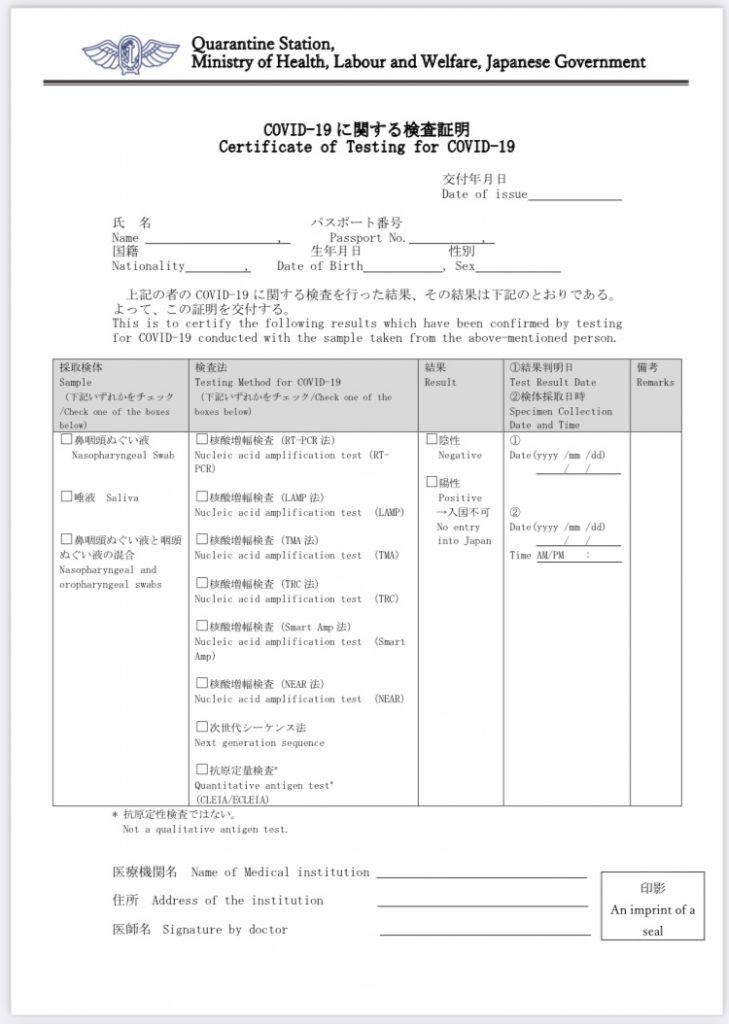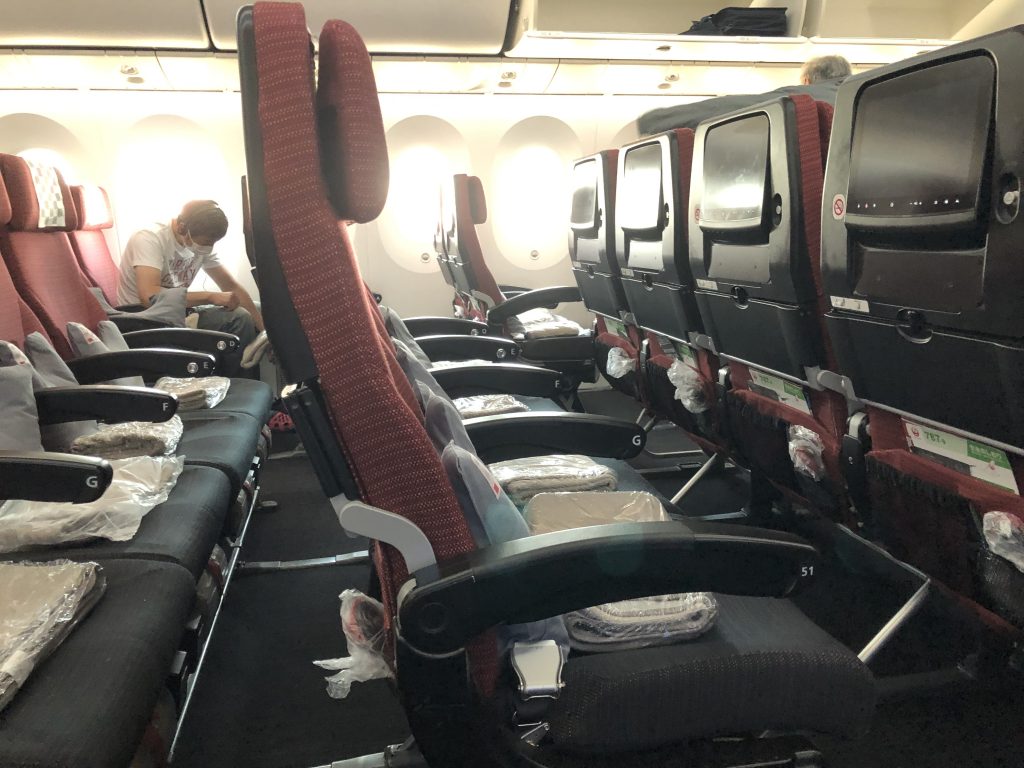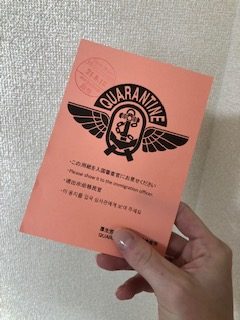The Process
It’s no secret. Trying to travel internationally is difficult right now because of reasons I’m sure everyone already knows. I’m truly lucky to have been able to make it to Japan even with all that has been taking place.
Today, I would like to strike a more informational tone so that whoever might be trying to enter Japan right now can get some details out of my experience.
The Preparations
To enter Japan, I had to obtain a Certificate of Eligibility, a visa, and a negative Covid test. The CoE (Certificate of Eligibility) was handled by my employer, so all I had to do was submit the appropriate documents. This included an application, picture of me, and some more paperwork involving my job.
Next came the visa. My passport, visa application, CoE, letter of purpose, flight itinerary, itinerary for my time in Japan, and an official letter from the Board of Education in Narashino were all handed off to the Japanese Consulate in Atlanta. Because of Covid-19, I had to provide more information than usual so as to prove that my ALT position had not been cancelled. The approval period had also taken a hit (what would normally take a week or two was now taking over a month), so timing became critical. Thankfully, I received my visa about a week before my departure!

The negative Covid test is, shall we say, a “new addition” to international travel. Those who want to travel to Japan must fill out a MOFA (Ministry of Foreign Affairs) form with information regarding how the test was conducted and when. A doctor’s signature punctuates the paper and marks it as legitimate. This test must be taken 72 hours (at most) from the departure time of the flight entering Japan.
As for myself, I took a sample document around to several different doctors to see who could conduct the proper test with a quick turnaround time. I finally settled on an Urgent Care, as they were able to conduct PCR tests and tended to have results by the next morning.
It feels strange to sum up what was months of Paper Panic in only a few short paragraphs! I’m so thankful that Ms. Keyes, the Executive Director for Tuscaloosa Sister Cities International, was there to guide me through the process!
I would also like to mention that prior to departing, I downloaded two apps onto my phone: the COCOA app (a way to be contacted if someone on my flight tested positive after our arrival) and the MySOS app (used to conduct check-ins about my location during quarantine). In addition to downloading these apps, I also filled out a questionnaire detailing where I had been for the two weeks prior to my departure. The questionnaire then gave me a QR code that I could show upon arrival.
The Flight
I flew from the Dallas Fortworth International Airport through Japan Airlines. Before boarding, each passenger was required to present their MOFA form and passport and explain their purpose for travel. I nearly fainted when I heard my name called over the loudspeaker! Once I approached the check-in, though, I realized that this process was required for everyone and that I had not, in fact, made a mistake.
There were maybe twenty-five people on the flight, including the stewardesses. I had never seen a plane so empty–so hauntingly empty–in my entire life. The flight attendants were wonderfully attentive and kind, which was definitely welcomed after all of the stress leading up to that point.

I’ve slept in many forms of transportation. Cars, trucks, buses, airplanes… being part of colorguard in high school and college taught me how to sleep sitting up, so I was fully prepared to get some shut eye that way. Imagine my surprise when one of the stewardesses came to me and explained that we were allowed to lay down in the middle row if we wanted to. I looked around, and sure enough, several other passengers were doing just that. Needless to say, I took her up on her offer, and even though I didn’t sleep very much, I can strike “Slept laying down on a plane” from the bucket list I didn’t even know I had.
During the flight, we were given some customs forms as well as some new Covid documents. The document included a pledge that detailed what my quarantine would be like once I arrived. I signed the pledge, gave contact details, and obtained what would become the most important document for my arrival: The “Where did you come from?” sheet, as each station during the Covid Arrival Procedures stamped or wrote something confirming I had completed whatever task or training I had been given.
Overall, the flight was truly simple and actually quite refreshing. I felt as though I was in first class with the amount of space around me! The food was fantastic, and everyone was kind and helpful. I’d highly suggest flying through Japan Airlines if it is ever an option for you!
The Arrival
Getting there is only half the battle.
For some people, the Covid Arrival Procedures can take nearly five hours. I was one of the lucky ones, and I was able to complete the procedures in about two. Here is a rapid-fire style summary of what happened:
1- Deplaned. Told workers what state I came from. Was guided to a line and told to wait. Then, we walked in a straight line for 15 minutes to the other side of the airport.
2- Arrived at Station 1. Showed my MOFA form and Pledge to workers. Because I came from Alabama, my “Where did you come from?” sheet was marked with the “lowest risk” category, meaning that I would be able to quarantine at home. This sheet then got the first of many stamps, as my state was written at the top.
3- Walked and walked and walked to Station 2. This was the covid test station. A sticker was put on the back of my passport- my testing number. The test was a saliva test, so I was guided to a private stall that had pictures of food hung up to get the juices going. I spit into a vial and went on my way.
4- Walked around the corner to Station 3. Here, my apps I had downloaded were set up. Got some more stamps on my “Where did you come from?” sheet.
5- The shock of everything set in, but I arrived to Station 4 with renewed determination. At this station, my questionnaire QR code was scanned, and I verbally confirmed that my answers were true. I had a slight hiccup when I forgot to tell the woman in charge that I had been to Georgia in the two weeks prior to my arrival, but it was an easy fix, and she added it to the “Where did you come from?” sheet.
6- Took an elevator to Station 5. I was taken to a room to wait for the results of my spit test. My “Where did you come from?” sheet was marked with my test number and seat number (I was seat A-10, for those interested). I waited for about forty-five minutes before being told my results were ready.
7- Station 6: “Congratulations, your results are negative. Please go to immigration next.” Music to my ears.
Let’s take a moment and breathe after all of that. How are you doing? Is the weather nice today? It’s pretty rainy here. Haven’t been able to hang my laundry outside.
Okay, break’s over. Time for immigration.

I presented my Negative Spit Test to the immigration officers and was guided to a station. I brought every document that I had been given up to that point, but unfortunately, I did not have a specific letter that customs required to prove that I was truly there for work. This letter had also caused trouble while obtaining my visa and had been sent directly to the Consulate and not to me, so I did not have it. They took me off to a separate room, and I was sweating bullets. Thankfully, they accepted the other documents I had brought, and they then issued me a residence card. This card is issued to those that are staying in Japan for longer than three months (basically, it is form of identification much like a driver’s license in the US).
The whirlwind only continued as I made my way to baggage claim. Customs was particularly interested in my PC-filled Pelican Case, as I had expected them to be, but they only wanted to pass it through the scanner. With that, I was free. Free and sleepy.
After bursting into the great-beyond of the rest of the airport, I was greeted by a senior ALT and my supervisor, who kindly drove me back home to my apartment.
The Quarantine

My quarantine is only two weeks in my apartment, so it is definitely doable.
To harken back to the apps I downloaded before departure, I have yet to receive any notification from COCOA, meaning no one I had come in contact with during the flight has tested positive for Covid.
The MySOS app, however, has been used daily. Around two or three times a day, I receive a notification prompting me to select the “I’m here” button to confirm my location. Every day between 11:00 and 2:00, I must Report My Health Condition through a short, two-question survey (“Do you have a temperature?” and “Do you have symptoms?”). I also receive phone calls through this app. During these calls, I must show my face and surroundings so that I can prove that I’m still quarantining. Sometimes they are robo-calls with no one on the other line, and other times they are manually operated. I have yet to receive one of the latter, but I have gotten a call at least once a day in the afternoon.
I’ve read online about health officers coming to people’s homes to conduct random covid tests, but I have yet to have anything like that happen to me.
One of the questions I was asked most before coming was “But what about food?” The answer is: It’s a gray area. The wording on the pledge states that one may leave their designated quarantine area only when “absolutely necessary,” so some may argue that getting groceries is a necessity. The pledge also states that you must not come in contact with anyone outside of your household, however, so an argument could go either way. After doing some research, many people that have asked those working the Covid Entry Procedures have received an all-clear for grocery shopping, but some others have also been told no. So it really depends on who you ask.
Before my departure, I did some research into what grocery delivery services were offered! The top options on my list were:
- Amazon Fresh was the easiest route in terms of variety, price, and delivery times. However, it is only offered in Tokyo and select surrounding prefectures. They do not deliver to me.
- A grocery service called “Life” within Amazon also offers groceries. The price is fair, and the delivery is free if you order over $80 worth, but there is not as much variety.
- Uber Eats is offered in Japan, as well! I’ve noticed that there are not many drivers available for my area in the middle of the day, but around 5:00 or 6:00 in the afternoon, the delivery option comes back.
Amazon has been a lifesaver. I’ve ordered some daily necessities, like towels and cleaning supplies, as well as shelving for storage. The delivery is amazingly prompt, as I can order something as late as 11:00 at night and receive it by 3:00 or 4:00 PM the next day! I have a nice corner dedicated to my cardboard box collection, which I will set out to be recycled on Saturday, provided there is no rain.
All in all, I think these procedures are warranted. With the case numbers exploding, I’d rather be overly cautious and follow the rules, especially given than I am new to the country! This post was a rather brief look into everything, so if anyone has any questions, I’d be happy to answer them in the comments.
Only eight days left to go!